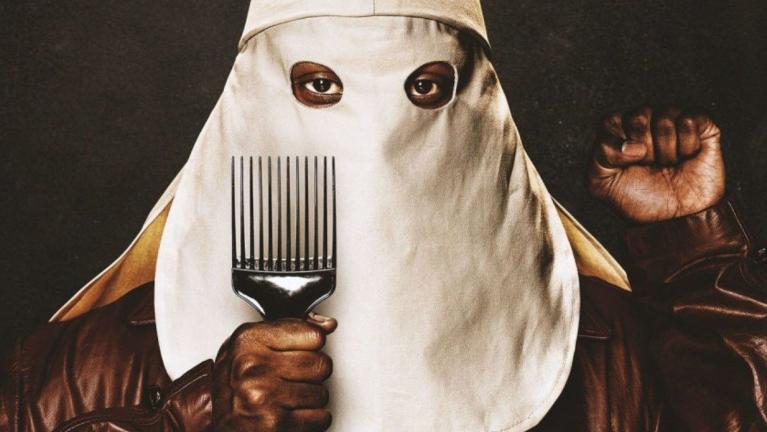BlacKkKlansman: Reel or Reality
Is Spike Lee’s newest film mere entertainment, or a deeper look at America?
BlacKkKlansman’s official poster that illustrates the movie’s premise of Ron Stallworth infiltrating the hate-filled Ku Klux Klan.
August 27, 2018
Confederate and Nazi flags cast perverse shadows inundating any surface they touch. Marching across the horizon, preparing for the bloodshed that would materialize mid-morning. The statue of former Confederate General Robert E. Lee was the spark for ardent white nationalists to voice their beliefs on the statue’s removal.
David Duke, former Grand Wizard of the Ku Klux Klan, came out to express his opinion with the support of fellow Klansmen and white supremacists.
“We are determined to take our country back,” Duke said. “We are going to fulfill the promises of Donald Trump. That’s what we believed in. That’s why we voted for Donald Trump, because he said he’s going to take our country back.”
Duke’s racist sentiments echoed decades earlier, when he sat atop his throne at the end of the 1970’s. However, in October of 1978, one of the most outlandish occurrences in American history took place.
Ron Stallworth, the first black detective at the Colorado Springs Police Department, sat at his desk, gazing over a newspaper. One ad for a local chapter’s PO Box stared at him. Out of impulse, Stallworth left a message for the Klan, expressing his hatred for anyone who lacked pure Aryan and white DNA. The phone rang at Stallworth’s desk weeks later, a Klan member on the other side. They agreed to meet within a week.
A black man had permeated into the KKK.
Spike Lee seized the story that would properly reflect aspects of the United State’s current social political climate.
BlacKkKlansman follows Stallworth’s infiltration of the Klan. After organizing meetings over the phone, his Jewish colleague Flip Zimmerman would converse with the local chapter in person. From there, they would extract inside information about the Klan. The investigation dug so deep the associates ended up meeting David Duke at a Klan gathering. Stallworth served as Duke’s bodyguard as Zimmerman went for his induction into the Organization.
BlacKkKlansman is a concrete film. Lee infuses his drama with comedy, pointing out how ridiculous the entire investigation was. Although I prefer to see such a serious drama exempt of humor, I see the importance – to add another layer to the tone of the film while expounding another aspect of the theme.
The entire cast gives excellent performances, with John David Washington (Stallworth) and Adam Driver (Zimmerman) standing out. The writing is sharp, providing the audiences with a gripping story from start to finish. Costumes and music draw you into Stallworth’s world. By far the best aspect of the raw filmmaking is the cinematography. The mixture of styles between The Disaster Artist and Isle of Dogs provide the film with a shot assortment that not only looks stunning, but brings the audience into the 70’s. The beginning scene of Kwame Ture’s speech is an epitome of this. Lee uses series of shots of people gazing up at a brighter future while reminiscing about a bleak past using an array of blues and purples.
However, there are real critiques against the filmmaking. The first act seems to drag on longer than it should, spending too much time fleshing out character, rather than developing it up until midpoint. However, right when it begins to feel drawn out, the film jumped into the second act. Stallworth also ends up meeting Patrice Dumas (Laura Harrier), president of the black student union at Colorado College, at a Ture speech. Dumas is a mediocre character, having a basic arc and a well-structured personality. However, her purpose is to be a catalyst for Stallworth’s inner-conflict: continuing his career as a cop or supporting black rights. This is why their relationship feels underwhelming. The scenes between them didn’t make me care about the struggles they were having as a couple, rather the strife Stallworth was going through. Dumas is never fully explored, so when she is a source of conflict audiences don’t have affection for her. An audience needs to relate to both in order to have a concrete relationship, and here we only cherish Stallworth. My substantial issue with BlacKkKlansman is Lee’s lack of subtly when defining his theme. It is blatant at the end of the film where clips of Charlottesville appear. Though I left the cinema agape, show do not tell is an essential part of any film. Rather than cloaking his themes in imagery and dialogue, Lee brazenly shows it to the audience.
Although the filmmaking is superb, that is not why this film has been a catalyst for discussion among many people. The story in the movie is principally dissimilar from what happened in real life. This is an imperative detail to note, especially when trying to understand the brilliance or failure of this movie.
The heftiest controversy surrounding the film is how Lee fabricates vital characters and plot points. Critics have said these falsehoods negatively impact the movie. However, story truths are an essential part of any historical film. Entertaining the audience is fundamental, but buttressing the film’s underlying theme and message is indispensable.
Zimmerman is a loose interpretation of Stallworth’s true unnamed associate, and his erroneous Jewish heritage is a highlight for this. The distortion heightens drama throughout the film, but this is not should not be looked down upon. Not only does it make the third act of the movie vastly entertaining, Zimmerman’s Jewish ancestry accentuates how foolishly anti-Semitic the Klan is. Around the end of the second act, he enters the basement of a chapter member’s house. Situated on a table, a lie detector with the purpose of exposing lies of one’s heritage is ready to use.
The idolization of Stallworth and his coworkers also sparked deliberation amongst critics. BlacKkKlansman has Stallworth mainly permeating the Klan, leaving out important details in his past. Lee left the three years where Stallworth had infiltrated black radical organizations out of his story. Portraying Stallworth as a man who was dedicated to halting only white animosity rubbed some critics the wrong way.
“First, BlacKkKlansman is not a true story,” Boots Riley, director of Sorry To Bother You, said. “A story not being ‘true’ is not necessarily a problem for me – I have no interest in telling them myself at this time – but this is being pushed as a true story and it is precisely its untrue elements that make a cop a hero against racism.”
After rebuffing a response, Lee acknowledged Riley’s critiques.
“Look at my films: they’ve been very critical of the police, but on the other hand I’m never going to say that all police are corrupt, that all police hate people of color,” Lee said. “I’m not going to say that. I mean, we need police.”
While Riley’s criticism have validation, the story Lee told was drastically different. Stallworth’s heroism did not intend to glorify police in a fight against racism. Rather, Lee was telling a story about a black man standing up to racism, albeit with white associates. Certainly the tolerant coworkers take the spotlight, but Riley fails to mention most cops in the movie are racist. In multiple scenes throughout the film, cops are persecuting innocent blacks. The contrast between prejudiced and tolerant cops in the same department exemplifies that Lee’s statement is true. Our country needs a police force in order to invoke laws. Despite the animosity of some cops, there are amiable tolerant cops all around the country.
Having a team of heroes also expounds another aspect of his theme. Racism is not solvable by a modest group of people. Its roots run deep in our country, to the point that aspects from decades ago are still present today. The reverence of Stallworth is a paragon of this. His heroism and immaculateness exemplifies why the heroics of one man cannot break the cycle of racism in a country with a history of it running through its veins. The downfall of Duke did not stop the Klan from asserting their intolerant ethics.
Lee ends on a poignant and ghastly note.
“Those people – all of those people, excuse me – I’ve condemned neo-Nazis,” President Donald Trump said. “I’ve condemned many different groups, but not all of those people were neo-Nazis, believe me. Not all of those people were white supremacists by any stretch.”
Lee delineates white supremacy is not only lurking in the shadows, but marching down the streets of our cities. Despite the blatant acrimony white supremacists have shown, our president has shielded and provided them with alibis. Duke has voiced his support for Trump, and the latter ostensibly ignores ardent backing. Trump’s antecedent proclamations make it more alarming.
“Black guys counting my money,” Trump said, according to a former hotel executive. “I hate it. I think that the guy is lazy. And it’s probably not his fault, because laziness is a trait in blacks.”
This is not where the conspicuous verbal aggression ends.
“I think sometimes a black may think they don’t have an advantage or this and that,” Trump said on a 1989 NBC interview. “I’ve said on one occasion, even about myself, if I were starting off today, I would love to be a well-educated black, because I really believe they do have an actual advantage.”
Sectarian comments have surfaced throughout Trump’s career, yet realizing his bigoted ideas have lingered to the present is paramount. Calling for a Muslim ban for aspiration of halting a flow of terrorists into the United States and construing Mexicans as rapists and drug lords is an epitome of his intolerant and naive behavior.
At the conclusion of the film, a fire is visible in the distance. As Stallworth glides along a protracted hallway, pistol in hand, he sees what truly lies in the middle of a shadowy field. Scorched and entangled in flames, white acicular hoods surround a cross. Suddenly, clips of Charlottesville appear. After staring at people wailing over their friends battered by cars, it is unequivocal what Lee has been telling us throughout the movie.
Trump and Duke alike have made crass unabashed remarks during their times of relevance. Stallworth’s story was a contingency for Lee to show the egregious parallels between Trump’s America and Duke’s. Lee brilliantly, if somewhat openly, constructs a link between the two using divergent stories, whilst pointing out how outrageous the values and behaviors of both the Klan and white ardent nationalists are. He seems to fathom the sheer asininity of parallels appearing after virtually four decades and longer.
Although some filmmaking and political critiques are legitimate, Lee has made a canny and seamless film worthy of its appraise. BlacKkKlansman has garnered three awards already: the Grand Prize of the Jury and the Prize of the Ecumenical Jury – Special Mention at Cannes Film Festival, alongside the audience award at Locarno International Film Festival.
Barring unanticipated masterpieces, BlacKkKlansman could be bound for Dolby Theatre February 24th.







